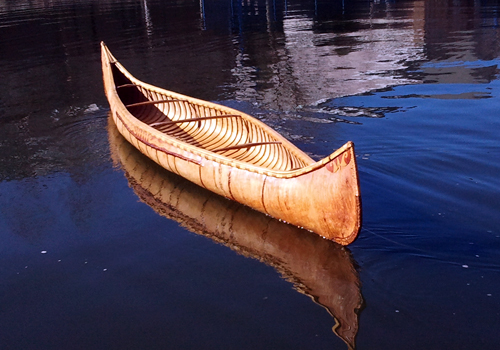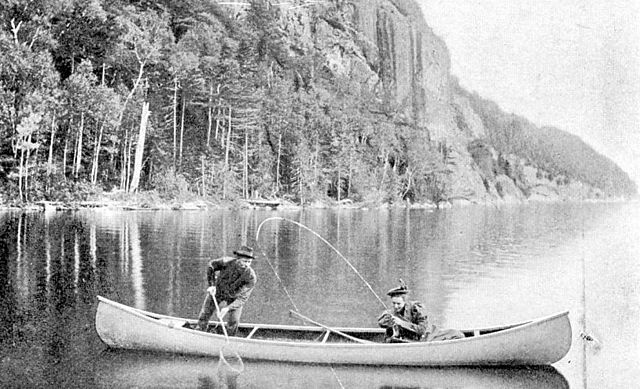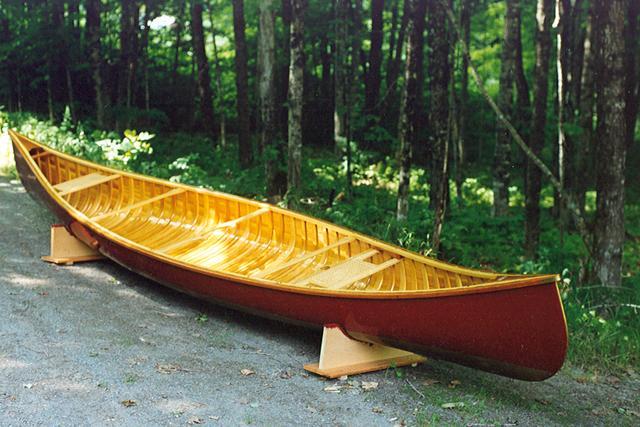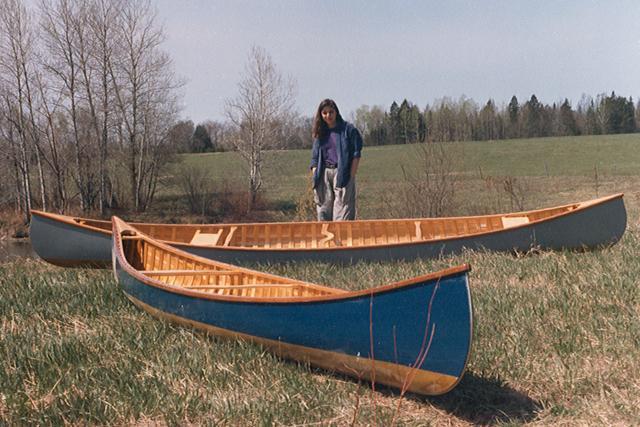Mr. Edward M. White started the E.M. White Canoe Company in the mid 1880s. He was one of the first people to build canvas over wood frame canoes, probably after seeing Evan Gerrish paddle one of his canoes on the Penobscot River where it flows through Old Town, Maine.
Canoes are things of beauty.1 I like the idea that water sculpted the canoe over hundreds of years of use. Native builders made modifications as they used canoes daily, and the evolution of canoe shapes was inevitable. No one knew this better than Edwin Tappan Adney. A Smithsonian scholar, Adney collected measurements and created line drawings and schematics of a hundred different variations on the canoe theme. Published in 1964 by the Smithsonian, Skin and Bark Boats of North America is the definitive scholarly work on birchbark canoes.
It was no surprise when some early Canadian builders in the 1850s replicated birchbark building techniques, replacing bark with canvas, which didn’t leak as much. These boats were built like a birchbark boat, outside-in, starting with laying canvas on the ground and adding structure to the inside. The boats were not consistent but were an improvement. Yankees improved the process by inverting the building process, creating first the framework and stretching canvas over the ribs and planks.

This is why my own birchbark canoe looks so, well, modern. Since water hasn’t changed its physical characteristics, why would a canoe shape be better because it’s modern?
Case in point: a few years ago a designer for a fairly well-known canoe company tried to make something “totally new.” It was a canoe-shaped object, and from the moment I saw the prototype I said “This dog won’t hunt.” We didn’t order any the next Spring, and the people who did (mostly big box stores with buyers who are more concerned with GMROI2 than paddlers) were soon disappointed that canoeists didn’t like them. They were ugly, and they paddled poorly. A double-threat to no one. The fact that I had to search far and wide for this image and finally found one on Sierra Trading Post is a good indication it didn’t meet sales expectations.

I have removed all names and logos. That way the designer and I can remain friends.
But let us purge our minds of such images (scroll down, quickly!) and focus on what is beautiful. Like anything E.M. White ever designed and built.

This is a photography of an E.M. White Wilderness Guide 18. The Guide was built in three sizes; 16, 18, and 20. The twenty footer was designed specifically for guides taking their clients into the bush in New England, so cargo room was paramount, and the ability to pole or paddle standing was of benefit for spotting a rising trout.
But the 18: goodness…I’ll just shut up and put up a picture.

Can you not see how this might be the object of desire of a canoelover? Or canoeluster? Sometimes it’s hard to distinguish between the two. Suffice it to say I have been bending the 10th commandment to the breaking point for over a quarter of a century. I wanted a Wilderness Guide 18. Not just to have, mind you, but to actually use as intended. Not to put in a glass case, but to paddle on glassy water.
Last year a friend of mine asked me to help him sell off his canoe collection. He was in a nursing home and not long for this earth, and he knew it. He wanted to make sure his canoes went to people who would appreciate them. There were few people in the position to help him out, and I know a few people who love canoes too. His sister sent me a list and I scrolled through them. And there it was.
An E.M. White 18 Wilderness Guide, built by Island Falls Canoe.

This picture was taken from Jerry Stelmok’s Island Falls Canoe website. To my knowledge, Jerry is only full-time canoe builder in the world who builds E.M. Whites. And that lovely grey-green canoe in the background is my canoe, when it was new.
Yes, I said my canoe. I called dibs on it, checked to see if it was okay if I paid them in installments. My friend said he wanted me to have the canoe.
It needed a lot of work. Sadly, the canoe had sat in his garage for years, with one side against a window, so the sun had oxidized the paint until it was white, and cracked the underlying filler. It would be possible to sand down to the canvas and reapply filler and paint, but I hate sanding so I decided to recover it and start over. This would also allow a few easy repairs.
I’ll be taking a trip with the 18 this fall. I can’t wait.
A lucky guy has the opportunity to find an E.M. White canoe once in a decade. A really lucky guy has the opportunity to find two in a year.
I am said double lucky guy.
I have wanted an Island Falls Willow since 1990, when I first read an article about them in Canoesport Journal, a now-defunct publication that was a great little rag about people who loved canoes, especially solo canoes. I am sure Jerry will correct me if I’m wrong, but I think the story goes like this.

Jerry was at a dump and saw what he recognized as the stem of an E.M. White boat sticking out of burn pile. He pulled it out and kicked some dirt on it to put out the smoldering end. He took it back to his shop, pulled the lines off it and they matched up almost perfectly with other E.M. White designs he had. It certainly was an E.M. White; it’s just that there was no record of it being built.
There are conjectures, of course. Perhaps it was a prototype that was built but was too tippy for the average paddler3 . No one will ever know for sure, but its DNA screams E.M. White.
Since these boats are all symmetrical, it wasn’t hard to turn to recreate the canoe from the part he had. So the Willow was born. Because of her initial “tenderness,” Jerry also build the Willowisp, six inches shorter and a little flatter on the bottom to make the new canoe more friendly to the beginner.
I sold a Willow to a customer twenty years ago or so. He wanted to get a lighter canoe, as he was getting older, and wanted a Kevlar boat to get the weight down to 30 pounds or so. I was delighted to trade him for a slightly used ultralight canoe for the not-so-ultralight-but-not-really-heavy Willow. It has seen some action, but the hull is sound and ready for Spring travel. My first solo trip when the ice is out will definitely be in this boat.
I own a dozen canoes, more or less. I paddle all of them, or else I sell them so they can be paddled. While these wood and canvas canoes are jewels, they’re not meant to be kept in a box on the dresser or on a rack in the garage. They are to be paddled. They are to be loaded down with a hundred pounds of canvas tent and packs, sleeping roll, wool blankets and a cast iron Dutch Oven. As much as I like 22 pound canoes and 35 pound packs, I also like fresh biscuits and a nice flank steak three days into a river trip. While I might dehydrate carrots, that’s so they’ll travel well, not to save weight. Weight? Who cares! I’m on a river, and the river is gladly carrying my gear for me.
I have owned a few wood canvas canoes, but I sold them, as none of them really had the feel of an E.M. White. The good news is that I have two of them; almost an embarrassment of riches. But I also have two children, and each will inherit one of these canoes. Yes, I am a good dad.
Respectfully submitted,
Canoelover
1. One could argue that the Coleman Ram-X canoe is not beautiful, but I can just as easily argue that it’s a canoe-shaped object, not really a canoe. I would win that argument. Statement validity remains intact.↩
2. Gross Margin Return on Investment. Businesspeak for “Does the item pay its own rent?” Because box stores sell items, not canoes.↩
3. This is a likely scenario, as the Willow is, as some say, a paddler’s boat. Without a load, she rolls over to the gunwale easily and if you’re not paying attention, will spit you out into the water without a thought. Loaded down, she settles down and is as efficient as a Prius with a tailwind. ↩

Great stuff, and thanks. I m’self, at a mere 71, am too old [bad knees, worse lower back] to be paddling anything heavy (I am down to my Bell solo, my Mad River solo, and my QCC “500”)…. I live in Dayton now (no lakes, but FIVE gorgeous rivers!) I love looking through [and sometimes even re-reading] Jerry Stelmok’s book. I am happy that you displaced the old owner entirely — not sure he ever “got” what canoes are, but you obviously did, and do.